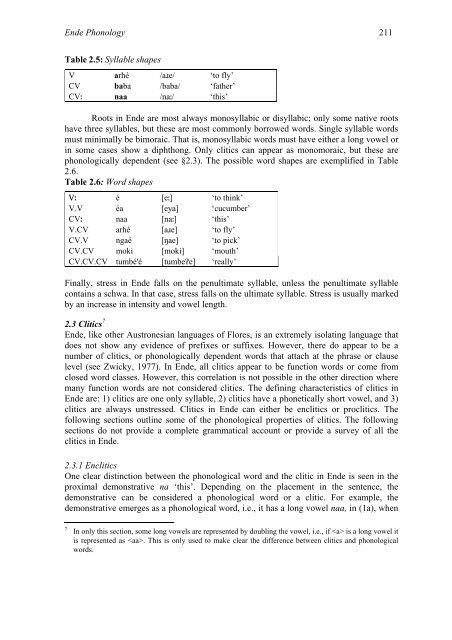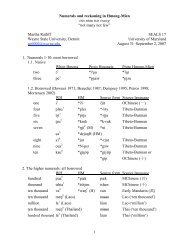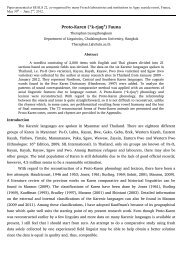proto-southwestern-tai revised: a new reconstruction - seals 22
proto-southwestern-tai revised: a new reconstruction - seals 22
proto-southwestern-tai revised: a new reconstruction - seals 22
Create successful ePaper yourself
Turn your PDF publications into a flip-book with our unique Google optimized e-Paper software.
Ende Phonology 211<br />
Table 2.5: Syllable shapes<br />
V arhé /a�e/ ‘to fly’<br />
CV baba /baba/ ‘father’<br />
CVː naa /naː/ ‘this’<br />
Roots in Ende are most always monosyllabic or disyllabic; only some native roots<br />
have three syllables, but these are most commonly borrowed words. Single syllable words<br />
must minimally be bimoraic. That is, monosyllabic words must have either a long vowel or<br />
in some cases show a diphthong. Only clitics can appear as monomoraic, but these are<br />
phonologically dependent (see §2.3). The possible word shapes are exemplified in Table<br />
2.6.<br />
Table 2.6: Word shapes<br />
Vː é [eː] ‘to think’<br />
V.V éa [eya] ‘cucumber’<br />
CVː naa [naː] ‘this’<br />
V.CV arhé [a�e] ‘to fly’<br />
CV.V ngaé [ŋae] ‘to pick’<br />
CV.CV moki [moki] ‘mouth’<br />
CV.CV.CV tumbé'é [tumbeɁe] ‘really’<br />
Finally, stress in Ende falls on the penultimate syllable, unless the penultimate syllable<br />
con<strong>tai</strong>ns a schwa. In that case, stress falls on the ultimate syllable. Stress is usually marked<br />
by an increase in intensity and vowel length.<br />
2.3 Clitics 7<br />
Ende, like other Austronesian languages of Flores, is an extremely isolating language that<br />
does not show any evidence of prefixes or suffixes. However, there do appear to be a<br />
number of clitics, or phonologically dependent words that attach at the phrase or clause<br />
level (see Zwicky, 1977). In Ende, all clitics appear to be function words or come from<br />
closed word classes. However, this correlation is not possible in the other direction where<br />
many function words are not considered clitics. The defining characteristics of clitics in<br />
Ende are: 1) clitics are one only syllable, 2) clitics have a phonetically short vowel, and 3)<br />
clitics are always unstressed. Clitics in Ende can either be enclitics or proclitics. The<br />
following sections outline some of the phonological properties of clitics. The following<br />
sections do not provide a complete grammatical account or provide a survey of all the<br />
clitics in Ende.<br />
2.3.1 Enclitics<br />
One clear distinction between the phonological word and the clitic in Ende is seen in the<br />
proximal demonstrative na ‘this’. Depending on the placement in the sentence, the<br />
demonstrative can be considered a phonological word or a clitic. For example, the<br />
demonstrative emerges as a phonological word, i.e., it has a long vowel naa, in (1a), when<br />
7 In only this section, some long vowels are represented by doubling the vowel, i.e., if is a long vowel it<br />
is represented as . This is only used to make clear the difference between clitics and phonological<br />
words.





